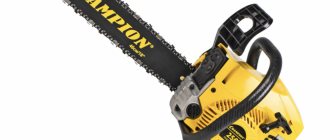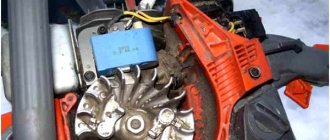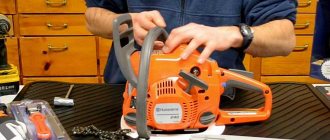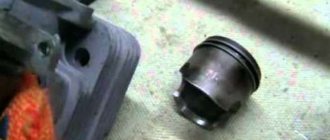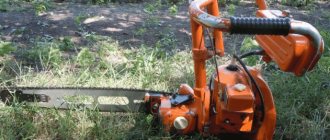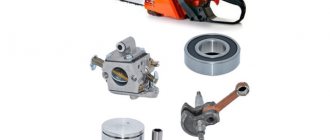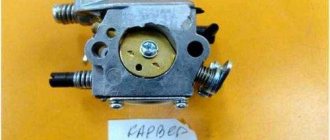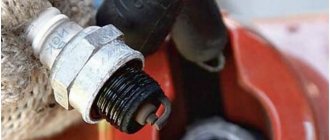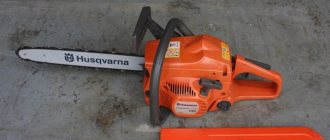Chainsaw carburetor design
Almost all carburetors used in the production of chainsaws have the same design. The only difference is the mechanisms with which Chinese garden tools are equipped.
As standard, the fuel unit consists of the following parts:
- float chamber - this element is designed to continuously maintain the required amount of fuel. When the unit is operating, fuel is transferred through a built-in nozzle to the atomizer;
- tube - through it, fuel enters in portions into the chamber. The fuel supply is regulated by the position of the built-in factory damper;
- atomizer - this part is necessary for injecting fuel into the intake air flow.
The operating principle of a chainsaw carburetor is quite simple. During operation of the unit, air is sucked into the tube and passes through it at a speed that is regulated by the built-in damper. When the damper opens, the float located in the chamber is activated. After passing through the diffuser, the air is mixed with fuel and instantly atomized. Next, the high-quality fuel mixture enriched with air passes through the intake channel and enters the engine cylinder. The diagram will clearly tell you about the operation of the carburetor.
The fuel circulates in the unit under pressure. In the float chamber it is close to atmospheric, but in the standard tube that sucks in the air, it is more rarefied. Due to the difference in the pressure generated, the fuel mixture enters the tube. The greater the amount of fuel, the higher the speed the engine of a household chainsaw can create.
Carburetor chainsaw device
Repair work is not complete without knowledge of the basics of the mechanism. By understanding the components and operating principle, it is easier to determine the cause of the failure.
Any malfunction in the carburetor threatens to stop the engine
The carburetor is one of the main functional parts of the engine, which is used to prepare and supply a fuel mixture consisting of certain proportions of fuel and air. As soon as the proportions are violated, the engine begins to “fail” or even stop working completely.
You can ensure proper operation of the carburetor by studying its “priming”:
- Tube with cross valve to regulate air flow.
- A diffuser is a constriction to increase air flow located at the fuel inlet.
- The nozzle from which fuel is supplied (fuel arrow in the diagram).
- A float chamber that regulates the fuel level at the entrance to the channel.
Here's what it looks like in a diagram:
Diagram showing the interaction of fuel and air flow
Operating principle: the air flow in the diffuser atomizes the fuel, creating a mixture that enters the cylinder. The greater the amount of fuel supplied, the higher the engine speed. Carburetors of different models work according to the same scheme.
READ How to Adjust the Carburetor on a Chinese Lawn Mower
How to flush a chainsaw carburetor?
You can clean the carburetor on a chainsaw using any aerosol cleaner. The brands Mannol, Hi-Gear and Nowax have proven themselves best. These compounds are good at cleaning the walls and parts of the carburetor from accumulated dust, carbon deposits and hardened resin.
Both Chinese and German carburetors are washed in the same sequence.
Cleaning the carburetor on a chainsaw is performed in the following order:
- First, you need to drain the used fuel remaining in the fuel tank. Next, you need to unscrew the mount and remove the protective cover of the chainsaw body, and also remove the standard air filter;
- Next, you need to remove the hose responsible for supplying fuel. To do this you will need to open the latches. After this, you need to unscrew the fasteners and remove the top cover of the factory assembly housing;
- Next you will need to remove the cover with the blue gasket, which plays the role of a fuel pump membrane. Near the body there are brackets in the form of springs. They will need to be removed and the screws removed;
- Then you need to unscrew the screw and carefully remove the needle valve. Directly below it is a built-in spring, which also needs to be removed. After this, you need to pull out the damper and the standard axle, carefully pulling them along towards you;
- After this, you will need to remove the drive arm, as well as the throttle body and its factory axle;
- All extracted parts of the chainsaw carburetor will need to be laid out on paper and their integrity checked. If necessary, worn parts must be replaced;
- Next, all dismantled parts must be washed with a spray can. The same must be done with the float chamber and carburetor body.
- After complete drying, all parts must be installed in the reverse order.
After washing, the carburetor will need to be installed in its regular place in the chainsaw. Next, you will need to start the garden tool and observe its operation at idle and maximum speed.
Chainsaw carburetor: design, principle of operation, malfunctions, maintenance and repair
Any chainsaw is equipped with a two-stroke single-cylinder carburetor engine. Early models of chainsaws were equipped with contact ignition, but now almost all manufacturers use electronic ignition, so there is no need to constantly clean the contacts and adjust the gap between them.
The air-fuel mixture to operate the engine is mixed in the carburetor. Using a special damper, you can manually lean or enrich the fuel mixture for a specific purpose - for example, for cutting hard wood.
Both the health of the engine and the performance of the chainsaw directly depend on the good technical condition of the carburetor. Let's take a closer look at how a chainsaw carburetor works.
Chainsaw carburetor design
Almost all chainsaw models use an identical carburetor design. As an exception, we can name the carburetor of some very cheap Chinese chainsaw - some parts may be missing, and most of the components are made of very cheap materials.
The main components of the carburetor are:
- Frame. It is made of aluminum to make the structure lighter and has a one-piece shape. The housing contains a diffuser, an inlet fitting, a pulse channel, a main screw and an idle screw, a damper that regulates the air supply, as well as other elements.
- Diffuser. Located at the carburetor inlet.
- Jets. Special valves through which the amount of fuel is regulated.
- Spray.
- Float chamber.
Approximate diagram of a chainsaw carburetor
The principle of operation of a chainsaw carburetor
Before you adjust the carburetor on a chainsaw, you need to understand the principle by which it works.
- When the engine starts, the air damper located at the bottom of the housing opens.
- A vacuum is created in the air channel and float chamber caused by the stroke of the piston, as a result of which an air flow is sucked through the diffuser.
- The intensity of the air flow suction is regulated by the position of the air damper.
- Gasoline enters the float chamber through the inlet fitting from the gas tank.
- The speed of passage of gasoline from the chamber to the diffuser is controlled by means of jets.
- In the diffuser, gasoline is mixed with air.
- The prepared air-fuel mixture enters the intake channels, from where it is directed into the working combustion chamber of the cylinder.
Basic carburetor malfunctions on a chainsaw
It should be understood that the dimensions of all holes are very small. Even the smallest contamination can block the flow of air or fuel, which is why filter elements are installed at the inlet ports. Unfortunately, they do not always cope with the task. The following signs indicate a malfunction of the chainsaw carburetor:
- High gasoline consumption and thick smoke from the exhaust;
- The engine “does not pull”;
- Floating speed;
- The engine starts, but stalls immediately or after a few seconds;
- The engine does not start at all.
- Chainsaw shoots at carburetor
All these malfunctions are a sign that the carburetor on the chainsaw is not adjusted correctly or that it is dirty. This implies the need for adjustment, cleaning or repair. Let's look at how to do this below.
How to properly adjust the carburetor on a chainsaw with your own hands
The factory settings of the chainsaw carburetor provide optimal fuel and air suction parameters. But during operation, they can become confused due to vibration - even a ¼ turn shift in any of the screws can lead to a serious change in the parameters for preparing the air-fuel mixture and it is necessary to adjust the chainsaw carburetor.
The chainsaw carburetor is adjusted using three screws marked H (High), L (Low) and S. The last screw, depending on the brand and manufacturer, may have other names, for example T or LA.
- H: is responsible for the operation of the main jet and regulates the maximum speed.
- L: adjusts the position of the idle jet and allows you to set low speed.
- S/T/LA: designed to regulate engine idle speed.
To know how to properly adjust the carburetor on a chainsaw, you need a technical passport - it indicates information about the angles of rotation of the adjusting screws. After this, we proceed directly to the adjustment. By the way, here you will need a screwdriver to adjust the chainsaw carburetor or a regular flat-head screwdriver:
- Place the chainsaw on a flat surface, preferably a table or something similar. IMPORTANT: The chainsaw must be positioned so that the bar points in the opposite direction. The engine must be turned off.
- Using a wrench or screwdriver, unscrew the fastenings of the housing casing cover and remove it to get to the carburetor.
- Remove the air filter that covers the carburetor for the chainsaw. The manufacturer may install a shock-absorbing foam insert on top of the carburetor - this must also be removed.
- Now begins setting up the chainsaw carburetor. Screws L and H must be tightened until they stop. Tighten them slowly and carefully so as not to break them.
- Unscrew both screws approximately 1.5 turns.
- Start the engine and let it run for about 7-10 minutes so that it warms up well - you won’t be able to adjust the chainsaw’s carburetor on a cold engine.
- After the engine has warmed up, set it to run at medium speed.
- Slowly begin to tighten the idle screw counterclockwise. You need to turn it until the motor runs smoothly. If the engine starts to stall, you need to continue adjusting the chainsaw carburetor and gradually return the screw clockwise.
After the carburetor of a Chinese-made or any other chainsaw has been adjusted, it is necessary to “drive” the engine at different speeds.
How to remove a carburetor from a chainsaw?
Either the engine does not start or stalls immediately, most likely the carburetor is clogged and needs to be cleaned. How to check a chainsaw carburetor? You'll have to take it apart - otherwise it won't work.
Before cleaning the carburetor on a chainsaw, it is still recommended to check other components: air and fuel filters, spark plug and muffler. It is possible that they are clogged - it is easier to clean the filter or replace the spark plug than to clean the carburetor on a chainsaw. By the way, it is the problem with the spark plugs that is the reason why the chainsaw shoots into the carburetor - ignition too late leads to the formation of an excess of the air-fuel mixture, since it does not have time to burn completely.
If the problem persists, you will have to remove the carburetor. It's very easy to do this:
- We remove the plastic back cover - it is held on by a latch or thread.
- Remove the air filter.
- Use a flat-head screwdriver to pry up the air rods and remove them. There can be two or three thrusts, depending on the model.
- The carburetor is secured with two fasteners - they are located diagonally. You need to unscrew them.
- Disconnect the gasoline hose that supplies fuel to the carburetor from the gas tank.
How to clean the carburetor on a chainsaw?
It is necessary to flush or clean the chainsaw carburetor only when it is removed and disassembled. Before cleaning, you need to prepare everything you need in advance: two screwdrivers (plus and minus), open-end wrenches, but preferably a head with attachments, clean rags, a special cleaning agent, a pump and an ultrasonic cleaner (recommended). Before you start cleaning, you need to drain all the gasoline - this is mandatory. After the remaining fuel has been drained and the entire instrument has been prepared, we proceed to cleaning:
- Detach the top cover and remove it.
- Carefully remove the fuel pump diaphragm.
- There are spring clips on the left side of the housing. After they are disconnected, you can see screws under the brackets - these also need to be unscrewed.
- Unscrew the bottom cover.
- By unscrewing the screw, you gain access to the needle valve. It and the spring located under it must be carefully removed, and so as not to dull the needle.
- The air damper is dismantled with a slight longitudinal force, after which the damper axis is removed.
- Lastly, remove the throttle valve, lever and axle.
After the carburetor is disassembled, all parts must be laid out on a flat surface on a clean rag. Carefully inspect each part for blockage or wear. Pay special attention to the jets and inlet fitting. Their clogging is the main reason why gasoline does not flow into the carburetor of the chainsaw.
If any part shows that it is very worn out, it is better to immediately replace it with a new one, so that in the future you do not have to think again about how to repair a chainsaw carburetor. Do-it-yourself cleaning of a chainsaw carburetor is done using a special detergent. You need to rinse each part well, and then dry them with a lint-free cloth, or better yet, with compressed air. All channels are also purged with air.
If you have an ultrasonic cleaner on hand, that's even better. Pour diesel fuel into the bath, carefully place the contaminated parts there for 5-10 minutes and after cleaning, dry them with compressed air.
Assembly is carried out in reverse order. A very important point is the installation of the needle valve - it must rotate freely in the seat. If the petal sticks, lightly press it or push it down so that it sits deeper.
After cleaning, it is strongly recommended to wait 20-24 hours to allow the cleaning agent to completely evaporate. Otherwise, it will mix with the air-fuel mixture and enter the cylinder, leaving carbon deposits on the walls after combustion.
Related Posts
comments powered by HyperComments
sadovij-pomoshnik.ru
Adjusting the chainsaw carburetor
This procedure is necessary specifically in cases where a garden tool does not start or, after starting, immediately stalls. Adjusting the carburetor of a chainsaw is also necessary when its power has dropped or the amount of fuel consumed has noticeably increased.
For self-adjustment, each manufacturer includes adjusting screws in the package of their garden equipment. The bolt, marked H, is used to adjust the position of the main jet and the operation of the internal combustion engine at high speeds. Bolt L is necessary for basic adjustment of the position of the built-in idle speed jet generated by the motor. Accordingly, the T screw is required by the chainsaw owner to quickly adjust the idle speed of the factory engine. In some cases, this bolt is also marked with the letters S or LA.
How to properly adjust the carburetor on a chainsaw?
Before setting up the carburetor on a chainsaw, you need to carefully prepare for the procedure. First of all, you need to find descriptions of the angles of rotation of the adjusting screws in the instruction manual. If you arbitrarily turn the bolts without following the manufacturer's instructions, this can lead to serious damage to the engine of the tool.
The motor itself must be in full working order. You should also thoroughly clean the air filter before tuning. Otherwise, it will not be able to pass air in the volume required to enrich the fuel mixture, which will lead to incorrect carburetor settings.
Adjustment of the unit must be performed on a flat surface. The saw itself should be installed so that its saw attachment is located away from the operator's feet and face. Immediately before tuning, you will need to remove the upper part of the protective plastic body of the tool, as well as remove the foam rubber and part of the standard air filter. To configure the unit, you will need a thin shaped screwdriver.
You need to adjust the carburetor of a chainsaw in 2 stages. The first one is basic. While performing it with the chainsaw turned off and the engine cold, you need to alternately screw in the bolts H and L in the clockwise direction until it stops. After this, each of the screws will need to be unscrewed 1.5 turns in the opposite direction.
Final carburetor adjustment is performed in the following order:
- First you need to start the chainsaw and give it time to completely warm up the engine. In this case, the gas lever should remain in the medium speed position;
- Next, the screw responsible for idling the engine will need to be turned slowly along the clock hand. This must be done until the internal combustion engine of the saw begins to operate stably;
- If during stable operation of the engine the chain moves along the tire, then the same bolt needs to be turned out a little in the counterclockwise direction;
- Then you will need to connect a manual tachometer to the motor. With its help you need to find high and low operation of the internal combustion engine. To do this, the adjusting bolts H and L must be turned alternately in different directions until the device shows the indicators indicated in the operating instructions.
At the end, the chainsaw you are using will need to be turned off and started again. It should operate stably at idle speed, and its chain in this mode should not rotate along the bus. When you press the gas trigger, the saw should quickly gain speed, and when it is released, it should release it.
How to clean a chainsaw carburetor
You will need
- - operating instructions for the chainsaw;
- — tachometer;
- - screwdriver.
Instructions
Familiarize yourself with the structure of the chainsaw outlined in the technical documentation for it. Determine the locations of the carburetor jets and adjusting screws. A standard carburetor usually has two or three screws that regulate the supply of the fuel mixture: an idle speed adjustment screw, as well as high and low speed jet screws.
Use the appropriate screws to adjust the high and low speed of the saw motor. They regulate the fuel to air ratio, which is determined by the degree of throttle opening. To lean the mixture, tighten the corresponding screw clockwise. If you need to increase the engine speed (that is, enrich the mixture), unscrew the screw by turning it counterclockwise.
The number of idle speeds is also adjusted by rotating the desired screw. Turn the control clockwise to increase the idle speed. To reduce engine speed, slowly rotate the propeller in the opposite direction.
When adjusting the carburetor, keep in mind that at the initial stage of operating the chainsaw, it is necessary to maintain the factory settings. The parameters set by the manufacturer are calculated for a richer mixture. After several hours of operation of the saw, you can begin to independently adjust the carburetor.
Warm up the saw at full speed for 10-20 seconds. Then unscrew the high speed jet screw counterclockwise. After ten seconds, use a tachometer to check the maximum engine speed and compare the data obtained with those indicated in the technical data sheet of the device. Too lean a mixture causes the saw to “squeal”; When the mixture is too rich, smoke appears from the muffler.
Be careful when changing settings, as sudden changes in high rpm will significantly affect the power of the device and the speed of the chain. Leaning of the hot mixture leads to unnecessary, excessive revolutions, which can lead to failure of the chainsaw.
Video on the topic
Sources:
- setting up a chainsaw carburetor video
www.kakprosto.ru
What to do if gasoline does not flow into the carburetor of the chainsaw?
The first reason for this failure is that the fuel filter is clogged with dust and dirt. This happens due to the presence of a large amount of harmful impurities in gasoline and the used motor oil. Over time, they accumulate on the surface of the filter, causing it to lose its ability to pass fuel. To solve the problem, you will need to thoroughly clean the filter by rinsing it in a bath of cleaning agent. If the filter develops holes or other signs of wear, it needs to be replaced immediately.
The second cause of failure is contamination or breakage of the tube through which fuel is supplied to the carburetor. If the hose is not torn, then cleaning it will be enough to thoroughly blow it with compressed air from an aerosol. If the tube is broken, it will need to be replaced. When installing the hose, the joints between it and the fittings must be carefully treated with sealant.
There is one more malfunction that occurs much less frequently than the previous two. It consists of a breakdown of the valve that regulates the rate of fuel supply to the carburetor. If dust or small chips get inside its mechanism, the damper is blocked and remains in the closed position. Repair of the unit can only be done by replacing the damper, since it most often cannot be restored.
Why does a chainsaw shoot into the carburetor?
Often, chainsaw carburetor malfunctions are associated with loud extraneous sounds that come from the unit. Ignoring them will lead to even more serious damage, which will be much more difficult to eliminate.
First of all, you need to understand the causes of extraneous sounds. The first of them is an incorrectly set ignition, due to which the used fuel does not have time to burn in the internal combustion engine cylinder in time. This leads to the formation of a short-term shooting noise that is repeated with each cycle of fuel injection into the cylinder.
To fix the problem, you need to adjust the gap between the flywheel and the standard ignition coil of the chainsaw. To do this, you need to remove the left protective cover of the plastic case and clean the parts underneath. To the right of the ignition coil there are 2 screws, turning them counterclockwise will allow you to move the flywheel away from the standard coil. Next, you will need to attach a template to the side of the coil and begin to slowly turn the factory screws in the opposite direction. As soon as the built-in flywheel comes close to the previously installed template, you will need to stop turning the screws.
After adjusting the ignition gap, you need to check the operation of the chainsaw. If it still fires, then you need to inspect the spark plug. If carbon deposits have accumulated on it, the part must be cleaned and completely dried.
Another reason why the chainsaw you are using is firing is due to the incorrect proportion of the prepared fuel mixture. If there is too little gasoline or motor oil, the engine of the garden tool will not be able to operate stably. In this case, you will need to completely drain the fuel and prepare the mixture in accordance with the manufacturer's instructions.
In some cases, a disturbance in the supply of fuel to the engine cylinder may be caused by improper operation of the standard carburetor jets. In this case, you will need to adjust the carburetor and alternately check the operation of the tool at idle, low and high speeds.
DIY Chainsaw Carburetor Repair Video
Content
, 142, 240, 365 with your own hands. video
Chainsaw. an indispensable assistant for every true master.
With the advent of the instrument, its popularity increased sharply.
Thus, the Husqvarna 142 chainsaw has high functionality. It is widely used not only in forestry, but also in households.
It's easy to choose a chainsaw. Therefore, it is best to pay attention to well-known brands such as Husqvarna. This company produces a wide range of such tools. Husqvarna 240 and other models are of high quality and functionality. But, unfortunately, even such tools are not immune to failures.
Possible faults
After a chainsaw appeared in the house, many owners breathed a sigh of relief.
After all, this tool allows you to solve complex problems quickly and easily.
But here it is worth considering that the chainsaw often fails. This is due to the fact that during operation it is subjected to high loads. Therefore, you should always be prepared to troubleshoot failures.
Today there are a large number of seminars that offer their services for repairing chainsaws and other tools. But this does not mean that if something malfunctions, you should immediately run to a repair shop.
Some problems can be fixed manually. To do this, you just need to know the main causes of failures and how to fix them.
READ The Best Chainsaws for Home and Garden
Thus, if the tool is used frequently, failures may occur:
- carburetor;
- muffler;
- oil pump;
- ignition and fuel supply systems.
Each of these failures can be eliminated with your own hands. Main. know the sequence of work when eliminating a particular malfunction.
For an article on self-repairing a 180 chainsaw, read here.
Ignition system
If a tool suddenly stops working, the first thing to check is the ignition system. And you need to start with a candle.
The work must be done very carefully. A special hook is used for this. First you need to disconnect the wire from the electrical outlet and remove the spark plug.
If it is dry, it means the cylinder is not receiving fuel.
Chinese chainsaw. Carburetor repair and adjustment. Carburetor diagnostics.
Chinese chainsaw
.Diagnostics and
repair
.
Carburetor repair
Carburetor
adjustment .
CHAINSAW STIHL MS 180 does not start well, - carburetor repair/ repair and carb tuning
In the video
carburetor repair
using a new repair kit of gaskets and membranes, adjustment
If there is a splash on it, the breakdown may be covered by the carburetor or in the starting rule. To fix the problem, you need to wipe the spark plug and turn off the fuel supply. After this the starter starts.
In this way, the combustion chamber is ventilated and excess fuel is removed. After this, the candle is inserted into place and the chainsaw begins.
If there is buildup on the spark plugs, this is an indication that your Huskvarna 137 gasoline is running on low quality fuel. In addition, the deposit is formed as a result of an incorrect ratio of fuel and oil. In order for the tool to work as long as possible, you need to carefully study the operating instructions.
READ Chainsaw Husqvarna Carburetor DIY Repair
If buildup accumulates on the plug, it should be removed carefully. You can use awl for this. The electrodes are carefully rubbed with sandpaper. After this, it is installed in place. Additionally, you need to fill the fuel that is recommended for this chainsaw model.
Here you can read an article about your interlocutor.
Problems with the fuel system
If the tool does not work, it may be because the cylinder is not receiving fuel.
First of all, you need to check the fuel filter for contamination levels. To check this, you need to remove the fuel hose and check how fast the fuel flows.
If it is supplied under little pressure, the problem is with the filter.
In this case, you need to clean the filter. It goes straight through the tank. The filter is cleaned and returned back. It is washed under running clean water.
After this, the filter is dried and carefully installed back. To prevent such a malfunction in the future, it is necessary to clean the filter periodically.
If cleaning the filter does not give a positive result, then you should pay attention to a breather. If this hole becomes clogged, the carburetor does not receive enough air.
Malfunction of muffler and carburetor
If the chainsaw is used frequently, the muffler may malfunction. This is very easy to determine.
READ Chainsaw For Wood Carving
If the tool is running normally and when the speed increases it starts to stop, then the spark arrester is the culprit.
Most often, this element fails as a result of contamination by combustion waste. You can easily solve this problem yourself.
First of all, you need to remove the muffler and disassemble it. It is worth considering here that in some models spark arresters are not understood. After this, the muffler is cleared of carbon. To do this, use special detergents.
When the deposit is removed, the spark arrestor is dried using a hair dryer. At the final stage, the muffler is installed in place.
As for the carburetor, its adjustment and repair can be done at home. But in order to perform such work efficiently, you need to know the structure of the carburetor and the principle of its repair.
Poor repairs can cause serious damage to the device. Therefore, experts recommend performing adjustments and repairs in special workshops.
As you can see, many chainsaw problems can be fixed with your own hands. But for this you need certain information. If you are not confident in your abilities, it is better to seek help from specialists.
Watch the video in which a specialist shows in detail the process of dismantling and reassembling for repairs with his own 142:
How to extend the life of a carburetor?
To prevent the breakdown of a standard unit, the owner of a garden tool should adhere to a number of rules. These include:
- using a properly prepared fuel mixture - each time you mix gasoline and engine oil, you must strictly adhere to the proportions specified in the operating instructions;
- use for refueling gasoline of the brand specified by the manufacturer - for operating an engine running on AI-92 gasoline, AI-95 fuel is not suitable, and vice versa;
- regular washing - cleaning the unit from dust and dirt accumulated on the walls will make its daily work easier;
- tuning the unit immediately after detecting problems - there is no need to delay adjusting the carburetor, as this can lead to even more serious damage.
During operation of the chainsaw, you need to ensure that dust, sawdust and small debris do not seep under its body. Otherwise, they will quickly clog the carburetor and block its operation.

